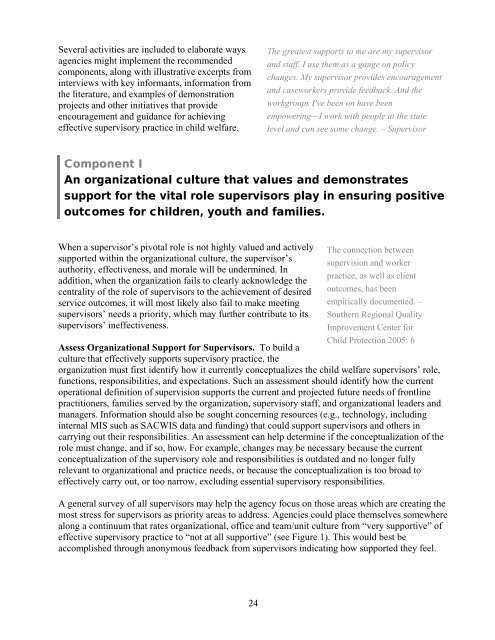Building a Model and Framework for Child Welfare Supervision
Building a Model and Framework for Child Welfare Supervision
Building a Model and Framework for Child Welfare Supervision
- No tags were found...
Create successful ePaper yourself
Turn your PDF publications into a flip-book with our unique Google optimized e-Paper software.
Several activities are included to elaborate waysagencies might implement the recommendedcomponents, along with illustrative excerpts frominterviews with key in<strong>for</strong>mants, in<strong>for</strong>mation fromthe literature, <strong>and</strong> examples of demonstrationprojects <strong>and</strong> other initiatives that provideencouragement <strong>and</strong> guidance <strong>for</strong> achievingeffective supervisory practice in child welfare.The greatest supports to me are my supervisor<strong>and</strong> staff. I use them as a gauge on policychanges. My supervisor provides encouragement<strong>and</strong> caseworkers provide feedback. And theworkgroups I've been on have beenempowering—I work with people at the statelevel <strong>and</strong> can see some change. – SupervisorComponent IAn organizational culture that values <strong>and</strong> demonstratessupport <strong>for</strong> the vital role supervisors play in ensuring positiveoutcomes <strong>for</strong> children, youth <strong>and</strong> families.When a supervisor’s pivotal role is not highly valued <strong>and</strong> activelysupported within the organizational culture, the supervisor’sauthority, effectiveness, <strong>and</strong> morale will be undermined. Inaddition, when the organization fails to clearly acknowledge thecentrality of the role of supervisors to the achievement of desiredservice outcomes, it will most likely also fail to make meetingsupervisors’ needs a priority, which may further contribute to itssupervisors’ ineffectiveness.The connection betweensupervision <strong>and</strong> workerpractice, as well as clientoutcomes, has beenempirically documented. –Southern Regional QualityImprovement Center <strong>for</strong><strong>Child</strong> Protection 2005: 6Assess Organizational Support <strong>for</strong> Supervisors. To build aculture that effectively supports supervisory practice, theorganization must first identify how it currently conceptualizes the child welfare supervisors’ role,functions, responsibilities, <strong>and</strong> expectations. Such an assessment should identify how the currentoperational definition of supervision supports the current <strong>and</strong> projected future needs of frontlinepractitioners, families served by the organization, supervisory staff, <strong>and</strong> organizational leaders <strong>and</strong>managers. In<strong>for</strong>mation should also be sought concerning resources (e.g., technology, includinginternal MIS such as SACWIS data <strong>and</strong> funding) that could support supervisors <strong>and</strong> others incarrying out their responsibilities. An assessment can help determine if the conceptualization of therole must change, <strong>and</strong> if so, how. For example, changes may be necessary because the currentconceptualization of the supervisory role <strong>and</strong> responsibilities is outdated <strong>and</strong> no longer fullyrelevant to organizational <strong>and</strong> practice needs, or because the conceptualization is too broad toeffectively carry out, or too narrow, excluding essential supervisory responsibilities.A general survey of all supervisors may help the agency focus on those areas which are creating themost stress <strong>for</strong> supervisors as priority areas to address. Agencies could place themselves somewherealong a continuum that rates organizational, office <strong>and</strong> team/unit culture from “very supportive” ofeffective supervisory practice to “not at all supportive” (see Figure 1). This would best beaccomplished through anonymous feedback from supervisors indicating how supported they feel.24
















